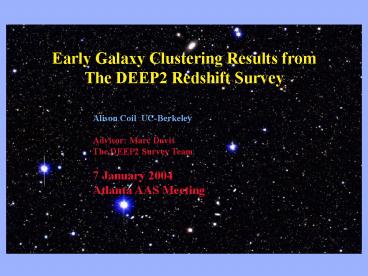Early Galaxy Clustering Results from The DEEP2 Redshift Survey - PowerPoint PPT Presentation
1 / 10
Title:
Early Galaxy Clustering Results from The DEEP2 Redshift Survey
Description:
... Survey, which uses the DEIMOS spectrograph on the Keck II telescope, will ... From the projected function wp(rp) we can recover the real-space correlation ... – PowerPoint PPT presentation
Number of Views:37
Avg rating:3.0/5.0
Title: Early Galaxy Clustering Results from The DEEP2 Redshift Survey
1
Early Galaxy Clustering Results fromThe DEEP2
Redshift Survey
Alison Coil UC-Berkeley Advisor Marc Davis The
DEEP2 Survey Team 7 January 2004 Atlanta AAS
Meeting
2
A Redshift Survey at z1
The DEEP2 Galaxy Redshift Survey, which uses the
DEIMOS spectrograph on the Keck II telescope,
will study both galaxy properties and the
clustering of galaxies at z1.
Comparison with local samples
- 3.5 sq. degrees
- 4 fields (0.5o x 2o)
- primary z0.7-1.4
- 50,000 redshifts
- 6106 h-3 Mpc3
- 90 Keck nights
- One-hour exposures
- RAB24.1
SDSS
2dF
LCRS
DEEP2
z0 z1
CFA SSRS
PSCZ
3
First DEEP2 Redshift Maps
redemission-line blackabsorption
02 hr field
16 hr field
4
2-point correlation function x(r)
x(r) follows a power-law prescription locally
x(r) (r0/r)g with r05 Mpc/h and g1.8. r0
scale where the probability of finding a galaxy
pair is 2x random
From the projected function wp(rp) we can recover
the real-space correlation function x(r)
(r0/r)g z0.7-0.9 r03.53
/-0.81 z0.9-1.35 r03.12 /-0.72 both have
slope g 1.66 /-0.12
Errors are estimated using mock catalogs -
dominated by cosmic variance
5
Galaxy Clustering color, type, luminosity
Color B-Rgt0.7 r0 4.32 (0.73) g1.84
(0.07) B-Rlt0.7 r0 2.81 (0.48) g1.52
(0.06) Spectral Type Absorption r0 6.61 (1.12)
g1.48 (0.06) Emission r0 3.17 (0.54) g1.68
(0.07) Luminosity Brighter MBlt-19.75 r0 3.70
(0.65) g1.60 (0.06) Fainter MBgt-19.75 r0
2.80 (0.48) g1.54 (0.06)
Redder, passively-evolving and/or more luminous
galaxies cluster more strongly than bluer,
star-forming, less luminous galaxies - similar as
z0 results
6
Galaxy bias galaxy/dark matter clustering
Bias evolves with redshift z3 b4 z0 b1
DEEP2 sample as a whole b0.96 /-0.13 for
s81 today b1.19 /-0.16 for s80.8 today could
be the result of our R-band target selection
were under-sampling older, red stellar
populations Coil et al. 2003 astro-ph/0305586
Galaxy formation simulation by Kauffmann et al.
greydark matter particles colorsgalaxies
7
Projected Angular 2-pt corr. fnct w(q)
Have photometry for many more galaxies than
spectra 350,000 galaxies over 5 deg2, incl.
zlt0.7 Projected angular 2-point correlation
function w(q) Constrain the 3d galaxy
clustering x(r) if the z dist. of the sources
is known
slope -0.8
7
3
Smooth decrease in clusering with magnitude.
Errors are variance across 15 pointings.
8
Evolution of Galaxy Clustering
Angular correlation function is an integral of
the 3-d clustering along the line of sight.
Use DEEP2 spectroscopic sample to measure the
redshift distribution of sources in various
magnitude ranges. Data is from the Groth Strip
where we have no photo-z cut 3320 galaxies.
dn/dzA z2 e(-z/z0)/z03
x(r,z) x(r,z0) (1z) (3e-g) e-1.2 fixed in
comoving coords. e0 fixed in proper coords. egt0
clustering grows in proper coords.
We find no single value of e fits our data e
must evolve with z. We see significant growth in
the clustering amplitude from zgt1 to 0.
9
Angular Clustering as fnct. of R-I color
In addition to a trend of redder galaxies being
more clustered, the bluest galaxies (R-I lt0.2)
are highly clustered unexpected!
red
blue
blue
Redshift distribution of color samples Reddest
galaxies are at z0.85, narrow Bluer samples are
at lower z, wider Bluest samples have significant
components at zlt0.5 and z1.7
red
10
Clustering as a function of R-I color
Corrected for zgt1.5 galaxies
Reddest galaxies are likely zgt0.5 progenitors of
local ellipticals
Bluest galaxies are a mix of brightest objects at
z1.7, local faint blue dwarfs, and QSOs between
z0-2

